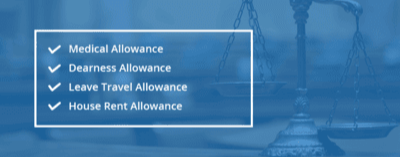Reimbursements are a special set of components that are part of the payroll. These components are typically introduced in payroll to extract maximum value from the salary earned. These are provisions made within the salary structure as benefits for the employee.
As the word suggests, reimbursements are money paid to the employee for some money that the employee has already spent.
All reimbursements are subject to upper limits being fixed by the organization or the appropriate government body. This means is that the employee can claim reimbursements (request for payment) only up to a certain limit.
Reimbursements are of two types:
- For out-of-pocket money spent towards business expenditure - An employee receiving reimbursement for money spent during a business trip or on any business-related item will carry 100% tax exemption as the reimbursement is not an ‘earning’ for the employee. One would usually file an expense claim for this reimbursement.
- For out-of-pocket money spent for the employee - Employee receiving reimbursements for money spent for his own expenses such as conveyance, adjusting towards inflation [Dearness Allowance (DA)], medical bills, house rent and travel during leave may or may not be taxable as per the Income Tax Act.
This blog series will cover only the second type of reimbursement i.e. for out-of-pocket money spent for the employee.
What is an allowance?
An allowance is the financial benefit given to the employee by the employer over and above the regular salary. These benefits are provided to cover expenses, which may be incurred to facilitate the discharge of service. For example, Conveyance Allowance is paid to reimburse expenses incurred for commuting to the workplace.
Apart from the Conveyance Allowance, the following are the most common allowances stitched into the Indian payroll system:
- Medical Allowance
- Dearness Allowance
- Leave Travel Allowance; also called as Leave Travel Concession
- House Rent Allowance
In some organizations, these allowances could be part of their Flexible Benefits Plan (FBP) package. Let’s take a closer look at these allowances…
Conveyance Allowance
Conveyance Allowance, also called as Transport Allowance, is a type of allowance offered to the employee to compensate for their daily commute between their residence and workplace.
Generally, the Conveyance Allowance is paid by the employer only if there is no transportation provided by the employer. In case an employer offers office transport, then this allowance will not be provided to their employees.
Limits and Rules of Exemption: There is no limit on the amount of Conveyance Allowance an organization can offer to its employees. However, there is a limit on the amount of exemption under the Income Tax Act, which is up to INR 19,200 per financial year or INR 1,600 per month.
The employee doesn’t need to furnish any documents or proofs of receiving Conveyance Allowance from the employer. The full amount of INR 1,600 pm can be claimed as tax exemption under Transport or Conveyance Allowance.
Medical Allowance
The Medical Allowance indicates that if the employee spends some money on medical expenses (buying medicines, paying doctor’s consultation charges, etc.), then the organization will reimburse (pay) the employee the amount spent by him/her when they submit the original bills.
Rules of exemption:
- An employee can claim an exemption on the amounts spent on medical expenses for self and dependent family members. Usually, the employee should declare the list of dependents to the company at the start of the financial year.
- The medical allowance/exemption is currently capped at INR 15,000 per financial year. The employee will need to produce original medical bills to claim this exemption.
Dearness Allowance (DA)
The DA is a component of an employee’s income, which is some fixed percentage of the basic salary, aimed at hedging the impact of inflation. Basically, the DA is a ‘cost of living’ allowance, which the government pays to its employees (both central and state employees), PSU employees and pensioners.
As DA is directly related to cost of living, the DA component is different for different employees based on their location.
For private limited or public limited companies, there is no compulsion to pay DA to their employees. Even if they pay, it can be calculated in any manner that they prefer. And it will be a deduction from the total income of the company.
Please note that the DA is a fully taxable component.
Did you know?
The concept of DA was introduced in India after the second World War and was initially known as ‘Dear Food Allowance’. Initially, DA was provided by the government to employees due to a demand for wage revision. However, it was later linked to the Consumer Price Index (CPI). A number of committees in the Central Government have been revising and restructuring the percentage of DA over the years now.
Leave Travel Allowance (LTA)
The LTA is an allowance paid to the employee by the employer when the former submits original travel tickets/invoices, which were used for travelling with their family or alone when the employee was on leave.
The amount paid as LTA is tax free. The LTA is one of the best tax-saving components that an employee can avail. It can be claimed only twice in a block of four years.
Multifold Benefits of LTA
Availing the LTA is beneficial for the employees’ mental wellbeing, as it encourages them to take leave and spend quality time with their family for rejuvenation and work-life balance.
RELATED POST: Leave Travel Allowance: Through a magnifying glass
Encouraging employees to avail earned/privilege leaves also helps organizations as they don’t have to encash leaves upon an employee’s exit or retirement, which can be significantly high in cases where employees avail very few leaves!
If you look at the bigger picture, LTAs indirectly boost the tourism and travel sector as more and more salaried individuals and their families travel during their annual leaves/vacations!
Maximum Claim Limit
Though, there is no upper limit defined for LTA by the income tax authorities, most organizations cap it for effective administration. The most popular upper limit capped for LTA is an employee’s monthly basic salary.
House Rent Allowance (HRA)
HRA is provided to employees to offset/balance the cost of living depending on the city/region they live in. The cost of living in a particular city/region can be higher or lower than other cities/regions of the country based on multiple factors, such as taxes, food expenses, cost of groceries and house rents.
Employees, who live in rented houses, can claim HRA to lower their taxable income. HRA can be partially or completely exempt from taxes. The HRA is for expenses related to rented accommodation.
For employees, who don’t live in rented accommodations, this allowance is fully taxable.
The calculation of HRA depends on the following four factors:
- The employee’s salary
- The HRA component of the salary
- The rent paid by the employee
- The location (city) of the rented residence
Rules of Exemption
The tax exemption on HRA is equal to the lowest of the following four amounts:
- Actual HRA received
- Actual rent paid reduced by 10% of salary
- 50% of basic salary, if the employee is living in a metro city
- 40% of basic salary, if the employee is living in a non-metro city
Generally, metro cities have higher house rents than non-metro cities. Therefore, the exemption percentage is higher for metro cities.
Closing notes
Allowances such as Conveyance and Medical Allowances, DA, LTA and HRA are benefits that are doled out to employees by the government or the organization. These allowances may or may not be taxable as per the Income Tax Act.
If there’s defined salary structure that includes most of these allowances (Conveyance and Medical Allowances being mandatory), employees can reduce their tax burden and increase their net pay.









